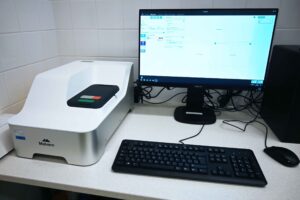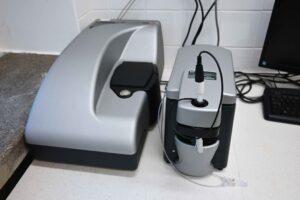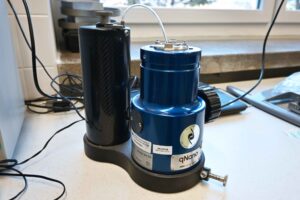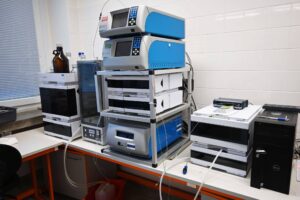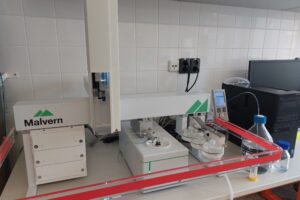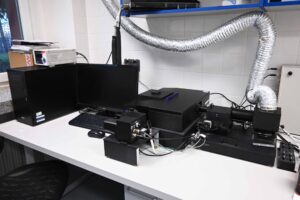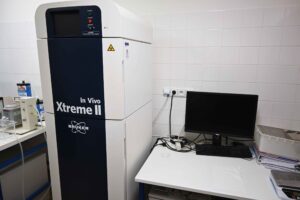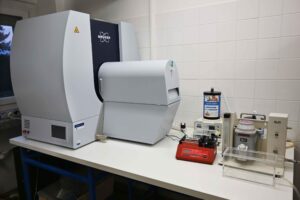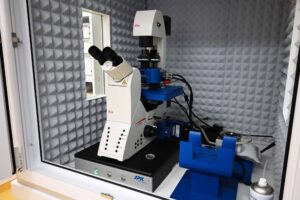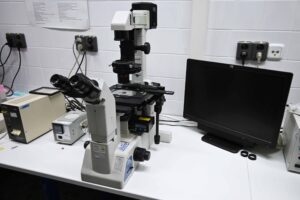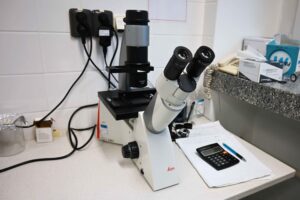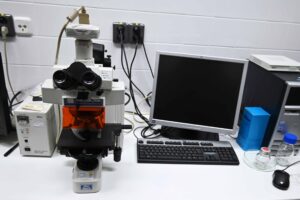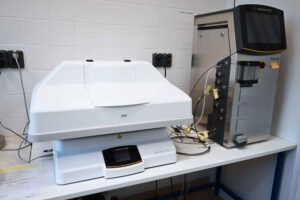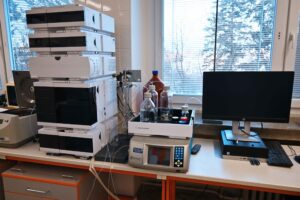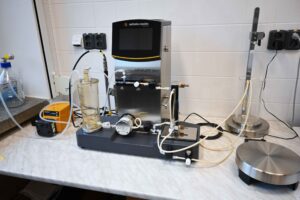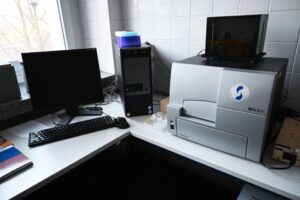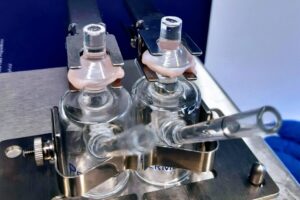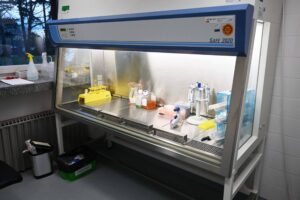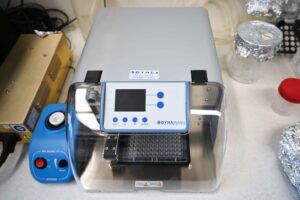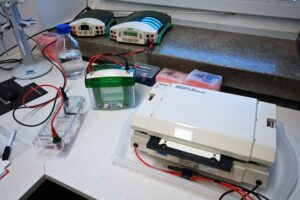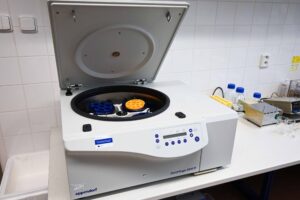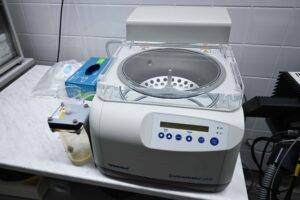Characterization of nanoparticles and biomolecules
The Zetasizer Ultra uses the Dynamic Light Scattering (DLS) and the Electrophoretic Light Scattering (ELS) techniques to determine the particle size (from 1 nm to 10 μm) and the electrokinetic potential, the so-called Zeta potential, which can be used to determine the stability of the colloidal system.
The Zetasizer Nano ZSP, an older model from the series Zetasizer range uses the Dynamic Light Scattering (DLS) and Electrophoretic Light Scattering (ELS) technique to determine the particle or molecule size and to determine the electrokinetic potential, Zeta.
The qNano uses the Tunable Resistive Pulse Sensing (TRPS) technique for the “particle by particle” analysis. The TRPS technique is based on measuring changes in the current flowing through the nanopore. Changes, referred to as resistive pulses, are due to the passage of particles (suspended in the electrolyte) through a given nanopore of an adjustable, defined size.
The Eclipse is the control unit for Asymmetric Flow Field-Flow Fractionation (AF4). This technique belongs to the chromatographic methods enabling separation of the biomolecules or the particles based on the hydrodynamic behaviour.
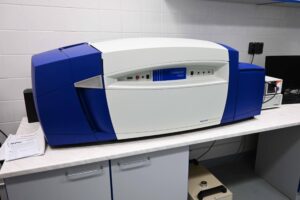
CD spectrometer Chirascan V100 (Applied Photophysics, UK)
Spectrophotometer with circular dichroism is used for biomolecule analysis and helps to understand the structure, features and interaction of biomolecules deeply. It is driven by software that enables precise setting up of the measurement as well as evaluation of results. The instrument contains a monochromator, air-cooled xenon lamp, photoelastic modulator (transfer of horizontally-polarized light to circularly-polarized light and an avalanche photodiode detector.
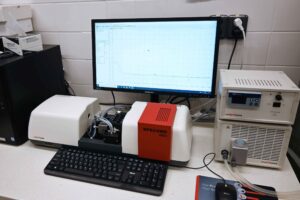
Specord S 600 (Jena Analyst) The high-performance diode spectrophotometer Specord S 600 is used to measure the transmittance and absorbance of liquid samples. It is designed for measurements in the spectral range 190 – 1020 nm, the entire spectrum can be read within 12 ms. The device is equipped with a Peltier cell equipped with a stirrer and an external thermo-block ensuring thermal stability. WinASPECT® software, extended by a module for determining kinetics, is used for data evaluation.
The Differential scanning calorimeter MicroCal PEAQ-DSC is an automated analytical instrument for characterizing the thermal stability of biomolecules. Characterization involves the determination of the enthalpy, heat capacity, and transit temperature of thermally induced structural changes in the molecule in a solution.
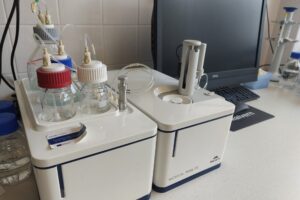
The MicroCal PEAQ-ITC isothermal titration calorimeter determines binding affinity, stoichiometry, enthalpy and entropy by directly measuring the heat released or absorbed in a given biochemical binding reaction. The instrument is equipped with a 200 μl measuring cell with an automatic sample injection (injection volume ranges from 2 μl to 80 μl with an error below 1%) and an adjustable temperature between 2 °C and 80 °C.
The Chronos DFD Fluorescence Spectrofluorometer characterizes the fluorescence properties of the analyte in solution. Characterization includes measurement of the stationary, polarized and time-resolved fluorescence. As a source of excitation light for the stationary and polarized fluorescence, the xenon lamp is used.
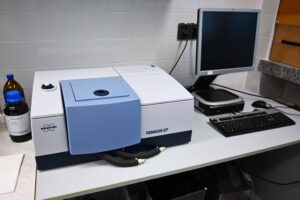
FT-IR spectrometer Bruker Tensor 27
FTIR spectrometer (Fourier transform infrared) Tensor 27 from the Bruker company enables the identification of molecules and materials. Compounds are arranged in a specific combination of atoms and the absorption of infrared light results in a unique spectrum. Therefore the instrument enables the qualitative analysis of organic compounds but also the secondary structure of proteins. Using digitalized libraries of IR spectra you can identify the unknown compound or determine the percentage of α-helix and β-sheet content in a protein structure.
Preparation of nanoparticles
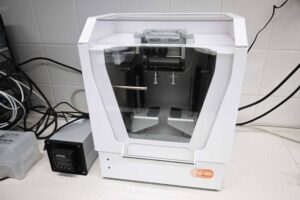
NanoAssemblr Benchtop
NanoAsemblr Benchtop instrument from the Precision Nanosystems company used microfluidic mixing for the production of defined nanoparticles. The principle is based on the laminar mixing of the aqueous phase and miscible solvent containing dissolved nanoparticle precursors in a capillary with a constant flow at a specific angle. The aqueous phase usually contains the encapsulated molecule (DNA, RNA, protein, etc.). The volume of the formulations might be from 1 to 15 ml.
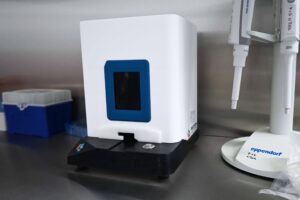
NanoAssemblr Spark
NanoAsemblr Spark is the smaller brother of the aforementioned model from the same company with the same purpose and the same principle of nanoparticle assembly. It uses sterile single-use cartridges for particle formulation according to pre-programmed settings. It is ideal for nanomedicine formulation discovery and screening at microliter scales. The working volumes can be scaled from 25 μl to 250 μl.
In vivo imaging
Microscopy
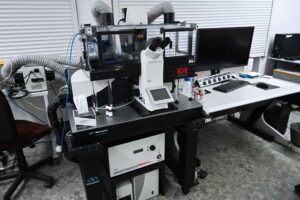
Confocal Microscope LEICA SP8 X
The Leica SP8 X is a high sensitivity confocal microscope system that offers complete flexibility for any fluorescence experiment. Therefore, this confocal microscope is used for top-class biomedical research and provides imaging precision for subcellular structures and dynamic processes. The microscope is equipped with a Diode laser 405, Argon laser, DPSS 561 laser, HeNe 633 laser and WLL laser (470-670 nm). Moreover, it contains 4 objectives (10x, 20x, 40x and 63x). Confocal microscopy enables advanced studies of localization of the proteins in cytoplasm and nucleus of the cells, both in live and fixed samples.
The Bruker JPK NanoWizard 4 BioScience is an extreme-performance atomic force microscope for biological applications. It is mounted on a Leica fluorescent microscope and is for AFM routines such as 3D visualization as well as physical evaluation of measured samples. It combines fast tip scanning with high-resolution scan sizes of up to 100 µm2.
Preparation and purification of recombinant proteins
The Biostat® RM is a GMP compliant, wave-mixing bioreactor. It is paired with single-use Flexsafe® RM bags and can be used for a broad range of different cell lines incl. Sf-9, Sf-21 insect cell lines, CHO, HEK293, stem cells, and CAR-T cells. The modular concept of the Biostat® RM works in the range 2 L to 50 L, provides flexibility to manage your individual process needs. Biostat® RM saves space, reduces costs, and increases yields. Flexsafe® disposable bags are equipped with sensors for measuring pH, O2, and temperature. The bioreactor works in a closed system that minimizes the possibility of product contamination.

LV1 Low Volume Microfluidic System from Microfluidics
The microfluidic instrument is used for cell disintegration (bacteria, yeast, insect, mammalian cells), and also for producing microemulsions and liposomes in a low volume with minimal sample loss. It is thus ideal for testing several conditions before transfer to larger volumes. The system contains ceramic cell through which the sample goes with the pressure of 2000 bar generated by a powerful compressor.

M-110L Microfluidizer Processor from Microfluidics
The microfluidic instrument is used for cell disintegration (bacteria, yeast, insect, mammalian cells), and also for producing microemulsions and liposomes in a volume of tens to hundreds of milliliters of a sample. The system contains a ceramic cell through which the sample goes with the pressure of 1200 bar generated by a powerful compressor and a compressed air bomb.
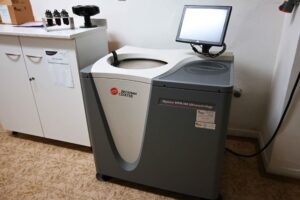
Optima XPN-100 Ultracentrifuge
Beckman Coulter’s Optima XPN-100 Ultracentrifuge is a high performance centrifuge optimized for spinning its rotor at speeds that can achieve speeds approaching 100,000 rpm or 802,000 x g. It features an imbalance detector that will prevent dangerous operations, a diffusions pump in series with a mechanical vacuum pump to increase spin efficiency, and interchangeable rotors and accessories to customize specific sample requirements. Its main purpose is to separate components of a sample through the use of relative centrifugal force. It has a wide range of applications ranging from separating blood to measuring conformational changes in proteins.
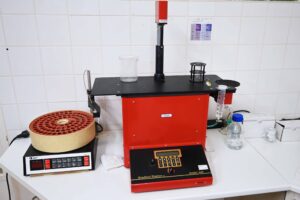
Piston Gradient Fractionator™
The instrument from the Biocomp company enables the generation of a linear gradient from two liquids with different densities in ultracentrifugal tubes. Besides that, after the ultracentrifugation itself, you are able to fractionate the sample – collect a specific fraction from the linear gradient without disturbing the gradient. The fractionation can be manually operated or to be fully automatic.
A high-performance liquid chromatography system from Agilent 1260 Infinity II series, is equipped with a Bio-Inert Multi-sampler with a ceramic needle allowing work in a metal-free environment. The 1260 Infinity II quaternary pump with a wide flow range (up to 10 ml/min) and a maximum system pressure of up to 600 bar enables both analytical and semi-preparative applications.
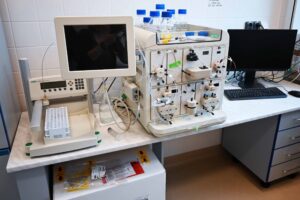
NGC Medium-Pressure Liquid Chromatography System
A liquid chromatography system (NGC – Medium-Pressure Liquid Chromatography System from Bio-Rad company) is primarily intended for protein isolation and purification. It is equipped with UV and conductivity detectors, an automatic sample collector and the intuitive software ChromLab. The instrument can be operated by PC also with the method design, or in a simplified version by an integrated tablet.

Fermentor BioBENCH
Stirred bioreactor BioBENCH from the Solida Biotech company enables the cultivation of microorganisms (E. coli, S. cerevisiae, P. pastoris), fungi and others in a temperature and pH-controlled environment with defined levels of dissolved gas (oxygen, carbon dioxide, nitrogen). Fermentor is equipped with four pumps for solution dosing (acids, bases, degassers). The working volume of the fermentor is 4 litres.
Other equipment
Franz Diffusion Cell (PermeGear, Inc)
PermeGear’s Diffusion System is an apparatus employing Franz Cells for carrying out in vitro/ex vivo release testing (IVRT) and in vitro/ex vivo permeation testing (IVPT). The system enables to measure the release or permeation of a compound into or through membranes. Franz Cells are used in the development of transdermal applications and for studying permeation into and through mucosal tissues.

